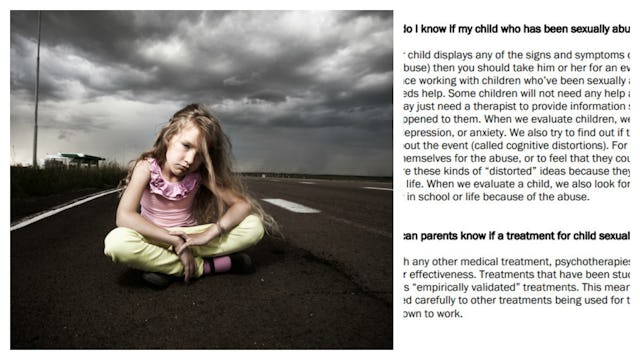Childhood Trauma Doesn't Just Go Away, So I Can't 'Get Over It'

According to the National Center for Victims of Crime, 1 in 5 girls will be molested. I am the 1.
It happened at a sleepover. We slept together downstairs, on the pullout couch in the living room. She was older by almost a year and coaxed me into doing things. I knew it was wrong. I was scared and intimidated and coerced. I knew I shouldn’t do it, but I did it anyway.
Molestation is only one kind of trauma that haunts childhood. Other kinds include, but aren’t limited to, physical assault; witnessing violence, like stabbings or shootings; chronic maltreatment; natural disaster; accident; war; medical trauma; the loss of a caregiver or loved one; emotional abuse; school violence; neglect; and terrorism. The National Child Traumatic Stress Network reports that one study found 68% of children had undergone a traumatic event by the age of 16. Rarely did those kids develop PTSD. But 20% did have academic, emotional, and physical difficulties. And the trauma doesn’t just magically disappear when you reach adulthood either. Its devastation reaches into the rest of your life.
Those sleepovers didn’t end. Because I was too scared to tell anyone, too scared not to do what the girl said, they kept happening. I was serially molested at the age of 7 by another child. Because yes, one child can molest another. I began to withdraw in school. This withdrawal made me the butt of teasing, which I was psychologically unable to cope with. My grades fell. I cried all the time.
When I say that trauma doesn’t go away, I mean that it doesn’t go away. According to the International Center for Trauma Stress Studies, those of us who underwent some kind of childhood trauma are often haunted by “anxiety, worry, shame, guilt, helplessness, hopelessness, grief, sadness, and anger” — emotions that are not necessarily obviously tied to the traumatic event. I’m prone to feeling guilty, for example, over things that aren’t my fault, like the kitchen being messy when I obviously had no time to clean it. More dangerously, childhood trauma also produces adults prone to “higher rates of anxiety, depression, suicide and self-harm, PTSD, drug and alcohol misuse and relationship difficulties.”
In my case, abuse triggered a latent depression that surely was lurking anyway, with my bad genes and its subsequent severity, but it wouldn’t have come so soon. Depression destroyed my childhood. Put it through a wood chipper and ate it. For various reasons, it remained untreated. I spent my childhood as the sad kid, the one with no friends, the one who cried. I cut myself. I stopped eating in a vain attempt to erase myself. I longed for suicide.
This did not magically end when I turned 18, or went to college, or hit some other arbitrary marker of adulthood. Trauma doesn’t just go away, and you can’t just magically get over it. It finds new cracks, develops new iterations. My abuse had told me I was worthless, and in the resulting depression (which also told me I was worthless), my parents didn’t help, leading me to the conclusion, yet again, that I must not be worthy of love.
The Association for Psychological Science says that one of the most common side effects of suffering childhood trauma is — you guessed it — a higher risk of developing depression, “a psychiatric disorder that is debilitating and in many cases fatal.” Moreover, studies have shown that “early-life stress appears to radically alter the neurobiological systems” related to depression. We can’t “just get over it.” The trauma we suffered is literally hardwired into our brains. One study, in fact, found that 75.6% of “chronically depressed patients reported clinically significant histories of childhood trauma.”
Ouch.
Eventually, I got help. A combination of cognitive behavioral therapy, recommended for abuse survivors and depression patients alike, plus psychiatric medication, has helped me reach a separate peace. People with PTSD have a number of treatment options available, including prolonged exposure, which involves “gradually approaching trauma-related memories, feelings, and situations”; cognitive processing therapy, which helps you “change your thoughts” about the events; and eye movement desensitization and reprocessing (EMDR), a therapy that involves paying attention to a back-and-forth movement while you recall the distressing memory. This sounds like some hippie nonsense, but it’s endorsed by the U.S. Department of Veterans Affairs, and my best friend, who has undergone a good deal of trauma in her life, has had a lot of success with it.
Childhood trauma is treatable. There is hope — we aren’t condemned to lives of miserable depression, relationship problems, and all the rest of the negative outcomes. But in order to save ourselves, we have to reach out and get help (usually with a nudge from another person; mine came in the form of my husband).
But just because some trauma happened when we were a kid doesn’t mean we can just “get over it.” There are thousands of children dealing with the trauma and hellish aftermath of Hurricanes Harvey and Maria. Thousands of children witness shootings and domestic violence. Children are sexually, physically, emotionally abused. Some are neglected. Theses things leave scars that don’t just go away. They rewire the brain. They literally change the way these children think, and we cannot expect that, as adults, they’ll just “get over it.” They need help. They need services. They need counseling and resources.
And most of all, they need assurance. They need security. They need the protective shield of a family to help them process and deal with what they’ve undergone. Because if they have that, perhaps they can escape becoming one of the depressed, the alcoholic, the anxious. They can’t get over it. But they can get help.
And so can we.